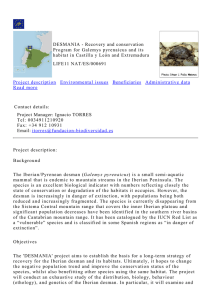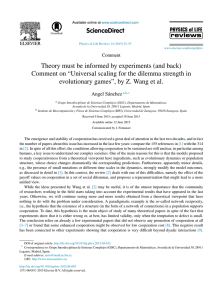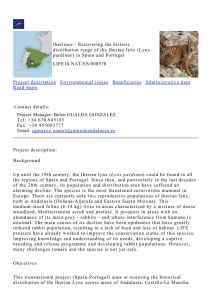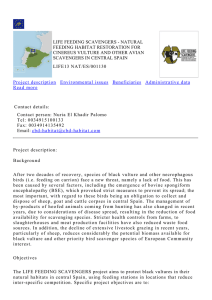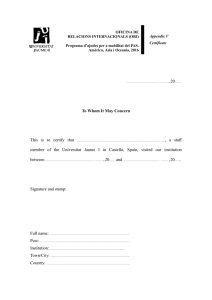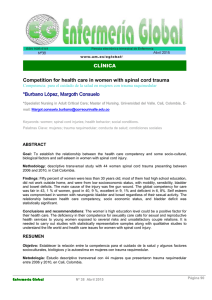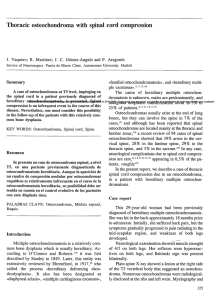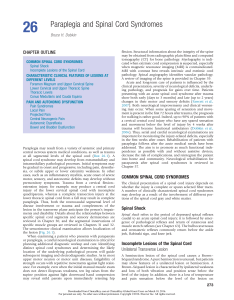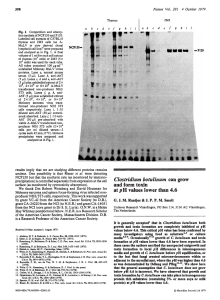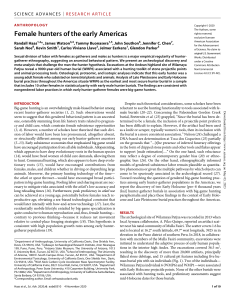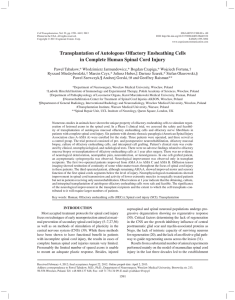The experience of identity transformation process for people living
Anuncio
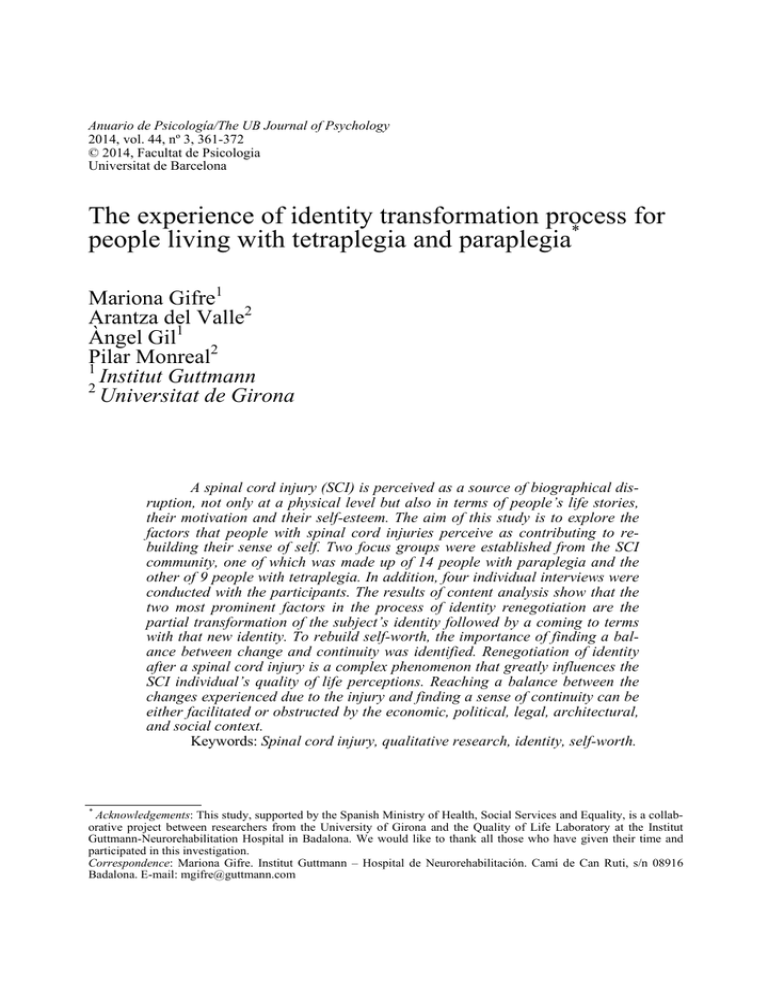
Anuario de Psicología/The UB Journal of Psychology 2014, vol. 44, nº 3, 361-372 © 2014, Facultat de Psicologia Universitat de Barcelona The experience of identity transformation process for people living with tetraplegia and paraplegia* Mariona Gifre1 Arantza del Valle2 Àngel Gil1 Pilar Monreal2 1 Institut Guttmann 2 Universitat de Girona A spinal cord injury (SCI) is perceived as a source of biographical disruption, not only at a physical level but also in terms of people’s life stories, their motivation and their self-esteem. The aim of this study is to explore the factors that people with spinal cord injuries perceive as contributing to rebuilding their sense of self. Two focus groups were established from the SCI community, one of which was made up of 14 people with paraplegia and the other of 9 people with tetraplegia. In addition, four individual interviews were conducted with the participants. The results of content analysis show that the two most prominent factors in the process of identity renegotiation are the partial transformation of the subject’s identity followed by a coming to terms with that new identity. To rebuild self-worth, the importance of finding a balance between change and continuity was identified. Renegotiation of identity after a spinal cord injury is a complex phenomenon that greatly influences the SCI individual’s quality of life perceptions. Reaching a balance between the changes experienced due to the injury and finding a sense of continuity can be either facilitated or obstructed by the economic, political, legal, architectural, and social context. Keywords: Spinal cord injury, qualitative research, identity, self-worth. * Acknowledgements: This study, supported by the Spanish Ministry of Health, Social Services and Equality, is a collaborative project between researchers from the University of Girona and the Quality of Life Laboratory at the Institut Guttmann-Neurorehabilitation Hospital in Badalona. We would like to thank all those who have given their time and participated in this investigation. Correspondence: Mariona Gifre. Institut Guttmann – Hospital de Neurorehabilitación. Camí de Can Ruti, s/n 08916 Badalona. E-mail: [email protected] 362 Identity reconstruction after a spinal cord injury El proceso de reconstrucción de la identidad de las personas afectadas de una paraplejia o tetraplejia La adquisición de una lesión medular es percibida como una disrupción biográfica no solo a nivel físico sino también a nivel biográfico, de intereses y valores. El objetivo de este estudio ha sido explorar los factores que contribuyen en la redefinición de la identidad en personas con lesión medular. Se realizaron dos grupos de discusión y cuatro entrevistas individuales con 14 personas con paraplejia y 9 personas con tetraplejia de la comunidad. Se realizó un análisis de contenido. Los resultados muestran que los principales factores en el proceso de renegociación de la identidad son la transformación parcial de la identidad y la definición de una nueva identidad. Hemos identificado la importancia de encontrar un equilibrio entre el cambio y la continuidad en la reconstrucción de un yo satisfactorio. Concluimos que la renegociación de la identidad después de una lesión medular es un fenómeno complejo que influencia la percepción de calidad de vida. El proceso para alcanzar un equilibrio entre los cambios experimentados y el sentido de continuidad está influido por el contexto económico, político, legal, arquitectónico y social Palabras clave: lesión medular, metodología cualitativa, identidad, selfworth. Introduction As a result of the problems, frustrations, and difficulties accompanying spinal cord injury (SCI), it is experienced not only as a physical transformation, but also as a major life disruption which could be described as a devastating loss of one’s individual sense of meaning and purpose in life. This disruption to everyday life has been conceptualized as biographical disruption (BD) (Bury, 1982). Before the injury occurred, an able body and indeed life itself had been taken for granted. Research studies have identified various factors in the SCI rehabilitation process that can contribute to coping with BD after SCI. Hammell (2004a) notes the importance of perceptions of self-worth, i.e., perceiving oneself as capable, competent, useful and valuable. Corbin and Strauss (1991) highlight the importance of a supportive social network and appropriate material resources, while Hampton and Baolian (2004) include the importance of reciprocal relationships. Somner and Baumeister (1998) theorize that restoring self-worth is fundamentally important to a worthwhile life experience. In the same vein, Lucke (1997) notes that people with SCI define the ‘major work’ of the rehabilitation process as ‘getting back together’, or reintegrating their sense of self. The need for a sense of continuity –of connecting one’s present and future lives to one’s past life– has been a recurrent research finding (Hammell, 2004a, 2007). Anuario de Psicología/The UB Journal of Psychology, vol. 44, nº 3, diciembre 2014, pp. 361-372 © 2014, Universitat de Barcelona, Facultat de Psicologia M. Gifre, A. del Valle, Á. Gil y P. Monreal 363 In short, in order to cope with the effects of a BD, individuals need to renegotiate their identity. This includes rebuilding their biographical narrative to recover a sense of continuity, engaging in relationships to achieve a sense that their life is of value to others, projecting future expectations so as to define new values and perspectives, and regaining a sense of responsibility for, and control of, their lives (Hammell, 2004b). However, according to Asbring (2001), coping with BD involves discovering which aspects of one’s identity have been lost, which aspects remain, and which new aspects have been added. The result of this is the redefinition of one's identity, or certain aspects of it, and the creation of a partially new identity based on the SCI individual’s new situation (Corbin & Strauss, 1987, 1988), equivalent to a partial identity transformation (Berger & Luckman, 1979; Närvänen, 1994). Thus, SCI has a significant impact on individuals’ sense of identity and life course (Chevalier, Kennedy, & Sherlock, 2009). Therefore, BD following an SCI and its consequences for individuals’ identities is a subject that requires considerably greater attention than received to date. Although a literature review shows sense of self to be an important factor in identity reconstruction, Hammell (2007) notes that the importance of affirming self-worth has not been emphasized in most previous studies, nor has the need for a sense of biographical continuity been specifically highlighted. The framework guiding this study is symbolic interactionism, a theory that focuses on the meaning that events hold for people and on the symbols which convey that meaning. Through experience and interaction with others, this meaning is continually developed and modified throughout life (Bruner, 2003). Symbolic interactionism is relevant to this study because the focus here is on how an individual’s experience of SCI affects prior conceptions of identity, how these conceptions can change, and how new conceptions are created in interaction with others. This study explores the rehabilitation experience following a spinal cord injury. It addresses the following questions: Do people affected by SCI create a new notion of their own identity and, if so, how are these new conceptions expressed? How do people living with SCI come to terms with a newly developed identity? Methods Rather than striving to fit researcher-selected dimensions of individuals’ experiences into existing theoretical frameworks, this study has attempted to understand participants’ own definitions of the process of coming to terms with a new identity, and how they express the factors that they felt contributed to (or detracted from) this experience. To do this, a qualitative approach was required. Qualitative approaches aim to describe the complexity of human experience in its context and emphasize the importance of describing daily events in peoples’ lives in their own words (Denzin & Lincoln, 1994). Anuario de Psicología/The UB Journal of Psychology, vol. 44, nº 3, diciembre 2014, pp. 361-372 © 2014, Universitat de Barcelona, Facultat de Psicologia 364 Identity reconstruction after a spinal cord injury Participants A convenience and purposive sample of 23 people with SCI was used. A total of 19 people (12 with paraplegia and 7 people with tetraplegia) participated in two focus groups. Four interviews were conducted, two with the paraplegic group and two with the tetraplegic group. All participants were selected from clinical records of the Institut Guttmann-Neurorehabilitation Hospital and participation was entirely voluntary. The sampling criteria are shown in table 1. TABLE 1. THE STUDY PARTICIPANTS (N = 23). Age at time of study Time since injury Level of injury Living situation Activity level1 Discharge Gender Education Context of habitual residence Exclusion criteria Range = 21 – 75 years Range 1-5 = 7, 6-15 = 7, +15 = 9 C3-C4 = 4, C5-C7 = 5, T1-T5 = 6, T6-T12 = 8 With family (origin or spouses) = 11, alone in own home with personal assistant = 2, alone in own home without personal assistant =4, institution =6 High = 9, medium = 7, low = 7 6-24 months = 8, more than 24 months = 15 Men =15, women = 8 High (university studies) = 6, medium (secondary studies) = 9, low (primary studies) = 8 Urban = 14, rural = 9 • Have psychiatric problems. • Have degenerative illness. • Lack of sufficient control of the language to be able to participate in a group discussion. 1 How many days during a week the participant does activities. For example: sport, work, social activities, etc. (high >5, medium 3-5, low <3). Instruments Focus groups were established to generate data that might not have been accessible without the stimulus of group discussion (Lau & McKenna, 2002). Focus groups capitalize on communication between research participants to generate data, by enabling participants to identify their priorities, to explore those issues they deem important, and to develop their own analysis of a common experience (Kitzinger, 2000). In-depth individual interviews were conducted to explore those aspects that had emerged during the group discussions and were considered easier to approach on a one-to-one basis. Anuario de Psicología/The UB Journal of Psychology, vol. 44, nº 3, diciembre 2014, pp. 361-372 © 2014, Universitat de Barcelona, Facultat de Psicologia M. Gifre, A. del Valle, Á. Gil y P. Monreal 365 Procedure Once the potential participants had been selected, they were contacted by telephone. Two discussion groups were established and four interviews were held. Each group and interviews lasted approximately 90 minutes. The focus groups and interviews were guided by the following issues: descriptions of participants’ everyday lives; the organizational structure required for participants to be able to undertake any given action; what participants would ideally like to do, and what they find that they cannot do. The questions were open-ended and were not asked in any specific order. Data analysis All focus group and interviews were audio taped and the tapes were then transcribed. Their content was analyzed using the grounded theory approach (Strauss & Corbin, 1991). Following thematic/content analysis, using ATLAS.ti software, data were converted from 'rough data' into 'useful data'. The analysis began with a reading of the transcripts to obtain a first impression of the data and to organize the information in relation to the objectives of the study. Category analysis was performed to fragment the analyzed texts and create meaning units. These first group’s calling codes are those that we believed best summarized the most relevant and meaningful information for our purposes. In the second step, we renamed the codes using the Constant Comparative Method (CCM) described by Corbin and Strauss (1991). This method includes data comparisons, highlighting similarities, differences and connections (Lau & McKenna, 2002). We created relationships between these codes and created a preliminary analysis of our ideas. Throughout this process, the names and content of the codes changed, new relationships were depicted, and possible interpretations were identified. From the first categorization of the data, we renamed, deleted, linked, etc. codes and focused on discovering those factors that people with SCI perceive as contributing to the reconstruction of their identity. During this procedure we identified 26 codes, which made reference to two categories: the first to change and the second to a sense of continuity. To ensure rigor we were used reliability criteria proposed by Lincoln & Guba (1985). Ethics The study was approved by the Ethics Committee of the Institut Guttmann. All participants signed a consent form and were given written information about the study and their contact person. In accordance with the study’s confidentiality agreement, no names are mentioned in this article. Anuario de Psicología/The UB Journal of Psychology, vol. 44, nº 3, diciembre 2014, pp. 361-372 © 2014, Universitat de Barcelona, Facultat de Psicologia 366 Identity reconstruction after a spinal cord injury Results The personal narratives of the participants’ life experiences after SCI were analyzed using thematic analysis. Among the numerous topics discussed during the focus group discussions and subsequent interviews, the following were identified as being the most salient themes affecting the process of identity renegotiation. The themes that emerged from the data were mutually entwined and must be understood holistically. The themes identified from the transcripts can be seen in table 2. TABLE 2. THEMES IDENTIFIED FROM THE TRANSCRIPTS. • • • • Autonomy, choice and control related to decision-making process and carrying out actions. Relationships: obstacle, need for constant planning and loss of comparability. Positive, meaningful activities, helping others and regaining self-value. Biographical disruption: change and continuity. Contextual issues: need for positive social reference models, and accessibility to supports designed to improve autonomy. A partial identity transformation High and low SCI was identified as a life disruption not only in relation to the patients’ bodies but also in relation to their biographical stories, their motivation and their self-esteem. It’s also all the emotional thing. When you break your neck and become tetraplegic the question is not about weeing or pooing. Your life is also broken (participant with tetraplegia). Nevertheless, a difference in the evaluation of the identity loss/BD impact was found between high and low SCI groups. For high SCI individuals, BD was radical and invasive in all aspects of life. When you are all right (referring to the time before SCI), it’s one thing; when this happens, it’s another world. From that point you are born again (participant with tetraplegia). Low SCI, on the other hand, was defined in terms of a need for a partial identity-transformation, You are the same person (participant with paraplegia). which implies relearning some aspects, but being able to maintain others. The need to find a balance between change and continuity was a common theme in both groups. Anuario de Psicología/The UB Journal of Psychology, vol. 44, nº 3, diciembre 2014, pp. 361-372 © 2014, Universitat de Barcelona, Facultat de Psicologia M. Gifre, A. del Valle, Á. Gil y P. Monreal 367 Now I don’t go diving but I do go fishing, and I take the suffering away. You have to change some things, but you also have to keep doing the same things in another way (participant with paraplegia). Participants saw able-bodied people’s difficulty in understanding their situation as an obstacle in their complex task of finding a balance between change and continuity. The able-bodied expect continuity in some aspects that SCI individuals feel have changed. There are all those things you have to think about, things which people who can move don’t even think about, and which they don’t think are important (participant with paraplegia). Two aspects were highlighted as being major obstacles for able-bodied people to comprehend the effects of SCI: 1. The loss of spontaneity in everyday life. The majority of participants noted the need for constant planning (even for carrying out basic everyday activities) as a major change in life that contrasted with the lives of the ablebodied. Before going anywhere you have to think about where you are going, where you will park the car, then you arrive hoping a disabled space is free… and so on… You have to do it like this, everything planned for living, thinking about everything in your everyday life (participant with paraplegia). 2. The loss of comparability with the able-bodied. Participants also included the impossibility of the able-bodied taking their place as a great obstacle to understanding some of the effects of SCI. I say to my wife, “It’s not the same... because you have your waist. Of course if you sit down and you’ve got your waist you can do everything,” but when you’ve got no waist, then you do it with one hand. When you sit a person on a chair it’s not the same (participant with paraplegia). Coming to terms with a new identity Sustaining a SCI implies different levels of identity reconstruction. While all the participants demonstrated that they had started the process of coming to terms with a new identity, they were all at different stages of progress. SCI and its consequences make individuals reorganize their everyday lives and recognize their dependence on other people to be able to carry out their daily activities. A balance between the changes experienced in various aspects of life and the sense of continuity necessary to maintain a biographical narrative is essential for reaching a new negotiated identity after SCI. Three themes have been identified as Anuario de Psicología/The UB Journal of Psychology, vol. 44, nº 3, diciembre 2014, pp. 361-372 © 2014, Universitat de Barcelona, Facultat de Psicologia 368 Identity reconstruction after a spinal cord injury central to achieving such a balance: redefining values and perspectives, recovering a sense of effectiveness and capability, and regaining responsibility and control: 1. Redefining values and perspectives. After an SCI, individuals need to learn to live/enjoy life in a new way. This involves organizing everyday life in a different way and requires a change in perspective, values, and priorities. They need a new perspective on life that allows them to find motivation and personal value as an individual and as a part of society. You change your chip, you keep adapting (participant with tetraplegia). 2. Recovering a sense of effectiveness and capability. Participants observed that after an SCI, feelings of uselessness and inferiority swamp their lives. Look at me, I can’t do anything. What can I do? (participant with tetraplegia). Our analysis highlights the importance of meaningful activities to generate a sense of competence and capability. Participants define meaningful activities as those with a high level of involvement in which they can manage changes, make contributions to others, and experience a feeling of continuity in relation to the past. Participants who have had SCI for more than five years tend to highlight the importance of helping others. They defined meaningful activities as the ones participants choose to do and enjoy doing, and that reinforce their relationship with friends, relatives, or any other significant person. Reading, computers, etc., are OK, but you cannot spend day after day doing only that. Other people help you, so you ask yourself, what can I do to help them? (participant with paraplegia). 3. Regaining responsibility and control. Immediately after an SCI, control and decision-making processes switch from the participants themselves to their caregivers and/or the context. Day to day it comes by itself, not through what you want (participant with paraplegia). This initial change has to be reversed, allowing SCI patients to take control and make decisions about their own lives. Being able to make their own decisions and to carry out their activities using the available resources increases SCI patients’ perception of being in control and their sense of autonomy. This is the central theme–to have supports and… let’s say… to have control over those supports (participant with tetraplegia). Anuario de Psicología/The UB Journal of Psychology, vol. 44, nº 3, diciembre 2014, pp. 361-372 © 2014, Universitat de Barcelona, Facultat de Psicologia M. Gifre, A. del Valle, Á. Gil y P. Monreal 369 Coming to terms with a new identity is a long and complex phenomenon. We have identified two strategies that usually help in the process. The first is living in a community. When in a care center, you have to live with all the other people inside. It’s not the same as having your own place, an assisted apartment that’s your home. An institution is not your own home (participant with tetraplegia). The second is having material and social resources designed to promote individual autonomy. The question is whether or not you get the support you need (participant with tetraplegia). Participants asked for a change in social resources to attain a level of autonomy that allows them to control their lives. Participants called for government support to provide personal assistants rather than the current tendency toward institutionalization or a permanent dependency on parents. In our research we found a small minority of participants who had barely come to terms with their new identity and were still grieving for their earlier identity. Some adopted a passive attitude when faced with the effects of SCI. It’s what you’ve got and you can’t change it (participant with tetraplegia). They believed that nothing could be changed and had even put their lives on hold. It took me five years to go out into the street (participant with tetraplegia). Others deal with the difficulties and limitations confronting them as unpredictable external forces. I try to lead the same life, and the problems still come (participant with tetraplegia). The lives of both groups are focused on their injury and their loss. Discussion This study aimed to explore the process of identity reconstruction after an SCI. Thematic analysis has provided many rich examples and characteristics of the processes of identity reconstruction, partial identity transformation, and coming to terms with a new identity in the approaches adopted by SCI patients. Anuario de Psicología/The UB Journal of Psychology, vol. 44, nº 3, diciembre 2014, pp. 361-372 © 2014, Universitat de Barcelona, Facultat de Psicologia 370 Identity reconstruction after a spinal cord injury A majority of the participants in this study described a biographical disruption in their lives after SCI, shifting from an identity associated with a high level of activity to one of inactivity. Until the new identity has been integrated with the earlier one, SCI individuals described themselves as either having two separate identities (one before the SCI and one after) or in terms of a comparison with the capabilities of the able-bodied. Once their new identity has been integrated (in our study this took more than 15 years after the SCI for individuals suffering from tetraplegia and 6 to 15 years after the SCI in the case of those suffering from paraplegia), individuals refer to themselves without this duality and compare themselves to other collectives such as women, immigrants, parents, or youngsters, depending on the context. The findings of this study indicate that many people with SCI (although not all to the same degree) come to terms with a new identity by giving up certain activities, carrying out others in a different way, and finding alternative interests. The empirical literature on SCI has focused on the concept of continuity as a more useful avenue for rehabilitation than the traditional preoccupation with loss and change. This has enabled people to see “that there are many important areas of their life that have been unchanged since the injury” (Boekamp, Overholser, & Schubet, 1996). This study, however, has identified the search for a balance between change and continuity as key to building/rebuilding a sense of self-worth. By applying the concept of partial identity transformation (Asbring, 2001), rehabilitation follows an integrated and holistic approach to change and continuity, where one cannot be understood or achieved without the other. Our findings lead us to conclude that the aim of rehabilitation should not only be to help SCI individuals find continuity, but also to help SCI individuals, their relatives, and their friends find a balance between change and continuity in order to achieve partial identity transformation. The findings also agree with Hammell (2004ab, 2007) in highlighting the importance of meaningful activities for defining new values and regaining control and responsibility, and our study highlights helping others as a main element of meaningful activities. The more time that has passed since the SCI, the more important the need to redefine activities that are important to others in the process of coming to terms with a new identity and providing the individual with a new sense of self-worth. The meaningfulness of activities is related to how much they contribute to feelings of capability and competence as well as to a sense of balance between change and continuity. Conclusions Identity transformation may be thought of as a factor that is generated and modified through relationships with significant others and is centered on sharing Anuario de Psicología/The UB Journal of Psychology, vol. 44, nº 3, diciembre 2014, pp. 361-372 © 2014, Universitat de Barcelona, Facultat de Psicologia M. Gifre, A. del Valle, Á. Gil y P. Monreal 371 activities, interests, values, and priorities. The process of reaching a balance between the changes experienced and a sense of continuity and a coming to terms with a partial identity transformation has been defined by participants as a constant, everyday effort. This effort may be assisted or obstructed by the economic, political, legal, architectural, and social context. Regaining a sense of control and responsibility and recovering capability and competence are thus collective and social challenges, not just individual tasks. To conclude, in order to support and enable SCI individuals to have a rich and fulfilling life, society in general, and health professionals and politicians in particular, need to listen, comprehend, and value an individual-based approach to dealing with SCI, rather than using predetermined criteria deemed important by researchers. REFERENCES Asbring, P. (2001). Chronic illness-a disruption in life: Identity-transformation among women with chronic fatigue syndrome and fibromyalgia. Journal of Advanced Nursing, 34(3), 312–319. doi: 10.1046/j.1365-2648.2001.01767.x Berger, P.L., & Luckmann T. (1979). Hur individen uppfattar och formar sin sociala verklighet [The sociology of knowledge. How an individual perceives and shape their social reality]. Stockholm: Wahlström & Widstrand. Boekamp, J.R., Overholser, J.C., & Schubet, D.S. (1996). Depression following a spinal cord injury. International Journal of Psychiatry in Medicine, 26, 329–349. doi: 10.1037/h0079091 Bruner, J. (2003). La fábrica de historias. Derecho, literatura, vida. México: Fondo de Cultura Económica. Bury, M. (1982). Chronic illness as biographical disruption. Sociology of Health and Illness, 2 (4), 167–182. doi: 10.1111/1467-9566 Chevalier, Z., Kennedy, P., & Sherlock, O. (2009). Spinal cord injury, coping and psychological adjustment: A literature review. Spinal Cord, 47, 778–782. doi:10.1038/sc.2009.60 Corbin J., & Strauss A. (1987). Accompaniments of chronic illness: Changes in body, self, biography and biographical time. Research in the Sociology Health Care, 6, 249–281. doi: 10.1046/j.1365-2648.2001.01767.x Corbin, J., & Strauss, A. (1988). Unending work and care: Managing chronic illness at home. San Francisco: Jossey-Bass. Corbin, J., & Strauss A. (1991). Comeback: The process of overcoming disability. Advances in Medical Sociology, 2, 137–139. Denzin, N.K., & Lincoln, Y.S. (1994). Handbook of qualitative research. Thousand Oaks, CA: Sage. Hammell, K. (2004a). Exploring quality of life following high spinal cord injury: A review and critique. Spinal Cord, 42, 491–502. doi:10.1038/sj.sc.3101636 Hammell, K. (2004b). Quality of life among people with high spinal cord injury living in the community. Spinal Cord, 42(11), 607–20. doi:10.1038/sj.sc.3101662 Hammell, K. (2007). Quality of life after spinal cord injury: Meta-synthesis of qualitative findings. Spinal Cord, 45, 124–139. doi :10.1038/sj.sc.3101992 Hampton, N.Z., & Baolian, D. (2004). Dimensions of quality of life for Chinese adults with spinal cord injury: A qualitative study. Disability and Rehabilitation, 4(26), 203–212. doi: 10.1080 /09638280310001639704 Anuario de Psicología/The UB Journal of Psychology, vol. 44, nº 3, diciembre 2014, pp. 361-372 © 2014, Universitat de Barcelona, Facultat de Psicologia 372 Identity reconstruction after a spinal cord injury Kitzinger, J. (2000). Focus groups with users and providers of health care. In: Pope, C. & Mays, N. (Eds). Qualitative Research in Health Care, 2nd ed. (pp. 20–29). London: BMJ. Lau, A., & McKenna, K. (2002). Perception of quality of life by Chinese elderly persons with stroke. Disability and Rehabilitation, 24(4), 203–208. doi: 10.1080/09638280110072922 Lincoln, Y., & Guba, E. (1985). Naturalistic inquiry. Beverly Hills, California: Sage. Lucke, K.T. (1997). Knowledge acquisition and decision-making: Spinal cord injured individuals’ perceptions of caring during rehabilitation. SCI Nursing, 14, 87–95. doi:10.1080/110381 20500542187 Närvänen A. (1994). Temporalitet och social ordning (Tesis inédita de maestría). Linköping University, Linköping. Sommer, K.L., & Baumeister, R.F. (1998). The construction of meaning from life events. In: P.T. Wong & P.S. Fry (Eds). The human quest for meaning (pp. 143-161). Mahwah, NJ.: Erlbaum. Strauss, A., & Corbin J. (1991). Basics of qualitative research: Grounded theory, procedures and techniques 2nd ed. Newbury Park, CA: Sage Publications. Anuario de Psicología/The UB Journal of Psychology, vol. 44, nº 3, diciembre 2014, pp. 361-372 © 2014, Universitat de Barcelona, Facultat de Psicologia
